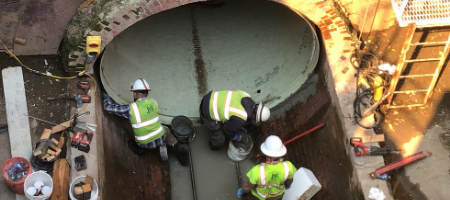Construction Management During Times Of Covid
By Don Poletski, P.E., and Molly Nause-McCord for the City of Portland Bureau of Environmental Services; Rick Attanasio, P.E., for Jacobs Engineering Group, Inc.

A successfully executed project comes down to its team. Close coordination among contractors, construction managers, inspection and safety staff, and suppliers is key to a successful, safe, efficient, and innovative project. However, it is 2020, and COVID-19 dictates that social distancing requirements be met, which means the traditional in-person weekly, construction, safety, and planning meetings must be replaced with virtual ones. These requirements compound in the field, where close site coordination and physical work must still be done. How does a construction team adapt management techniques during a pandemic?
The City of Portland’s Bureau of Environmental Services (BES) began planning and design in 2012 for the rehabilitation of the 114-year-old brick sewer known as “Taggart Outfall” in Portland, Oregon. This project rehabilitated 3,700 feet of large-diameter brick tunnel — from 58 to 120 inches in diameter with depths varying from 20 to 100 feet — that occasionally runs under buildings and other features. The project was designed by Jacobs Engineering Group, with construction management and inspection provided by the City of Portland, Bureau of Environmental Services. The rehabilitation of the pipe was achieved via sliplining using a fiberglass-reinforced pipe (FRP). Only one viable location existed for the pipe insertion shaft; from that single point of entry, sliplining sections needed to be threaded through three major bends and a section of previously installed tunnel liner plate.
In order to install the custom-fabricated sliplining sections, the contractor, James W. Fowler Co., proposed to shuttle the pipe into place with an electric mining locomotive and rail car system running inside the existing sewer tunnel. To facilitate that, 2,725 feet of steel track was installed in the flow line of the tunnel through the three bends and existing tunnel liner plate section. The sliplining pipe segments had an outside diameter of 108.6 inches; while the host pipe had an internal diameter of 116 inches, it necked down to 113 inches through the bends and liner plate, leaving little room for error.
While this project would have been difficult to execute under any circumstances, COVID-19 distancing and health protocols made it even more challenging. To facilitate remote collaboration, a common digital platform that all team members could comfortably use was set up. It was important that the platform work on phones as well as computers. After considering all software options, Microsoft Teams was selected and subsequently used for all meetings — from large-scale preconstruction coordination and weekly project meetings to one-on-one collaboration in lieu of in-person meetings. This approach allowed for social distancing and supported the remote workplace locations dictated by the pandemic. Additionally, BES used “e-Builder,” its standard project management platform, which includes accepted procedures and specifications. The combination of Teams and e-Builder provided a robust communal platform for coordinating construction documentation digitally.
In the field, each site task had to be reimagined with COVID in mind. Safety plans were updated to achieve compliance with CDC and BES recommendations with the goal of not only keeping project staff safe from potential construction hazards, but also minimizing transmission of disease. Onsite initiatives included these:
- Requiring masks of varying levels of protection, from cloth face coverings to N95 or SCBA level, based on the task
- Limiting site visitors to essential project-level staff only
- Displaying posters encouraging employees to stay home when sick
- Installing no-touch disposal receptacles
- Providing handwashing stations with soap and procedures
- Providing hand sanitizer to project staff
- Enforcing a six-foot physical distancing protocol at all times, including during confined space entry into the tunnel. When six feet could not be maintained, increased mask levels were required, such as an air-purifying respirator (APF 10), N95 or KN95 mask, or elastomeric mask.
- Requiring staff with a confirmed case of COVID in their home to notify their supervisor.
- Conducting mandatory temperature screening of every staff member at the start of each shift. Temperatures below 100.4ºF (37.8ºC) were recorded as “no fever.” For temperatures of 100.4 ºF or above, a procedure was established to have the staff move to a designated isolation area to be re-tested after 5 minutes to eliminate false positives. If both temperatures exceeded 100.4 ºF, the staff member was sent home and the Exposure Control Plan implemented. The affected staff was responsible for reporting their status to their supervisor and HR department.
The Exposure Control Plan required staff who had been designated as sick because of an elevated temperature or other symptoms such as acute respiratory distress to be isolated from other team members. Sick staff members were then required to stay home until they were free of symptoms and/or fever for more than 48 hours without the use of fever-reducing or symptom suppressant medicines.
The number of City site staff was reduced to the bare minimum required onsite while continuing to ensure the standard responsibilities of quality control, erosion control, documentation, and safety were met. They also became responsible for enforcing all COVID safety procedures. Any issues or deviations from established COVID procedures were addressed immediately by City and contractor management staff.
While construction management during a pandemic certainly adds another level of complexity, it can be done. With careful coordination, planning, foresight, and persistence, it is possible to successfully deliver even the most challenging and innovative of projects. Such was the case with the Taggart Outfall. While getting to the finish line was not a straight path, the team worked together to find new ways to communicate and prioritized protecting each other from potential exposure to the virus. It required setting aside some past procedures, being open to trying new ones, and spending a whole lot more time on the phone! In the end, the pipe was laid, on schedule and within budget, while minimizing the spread of the virus among the project team.
